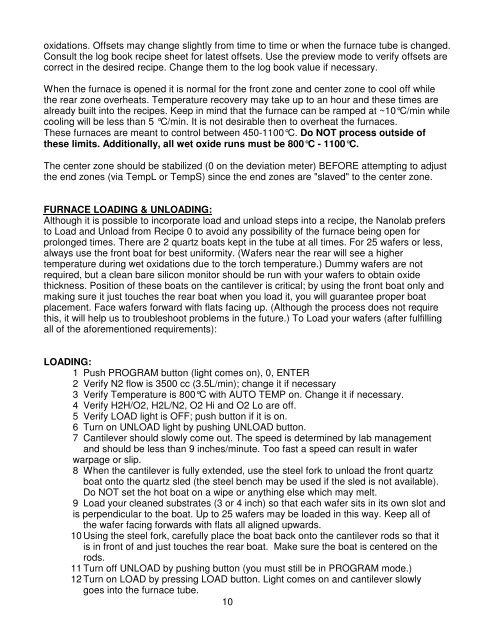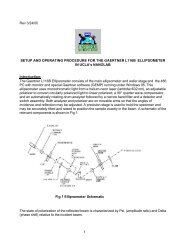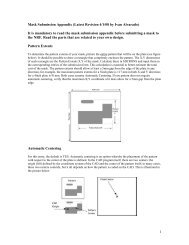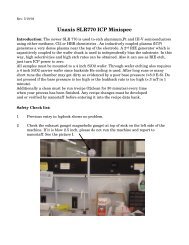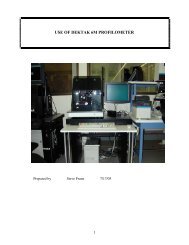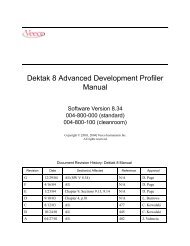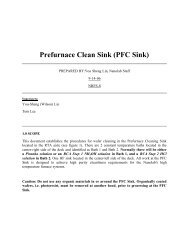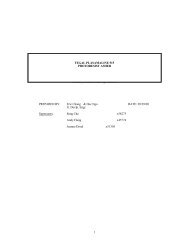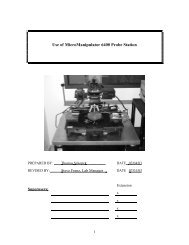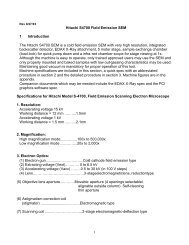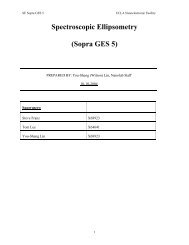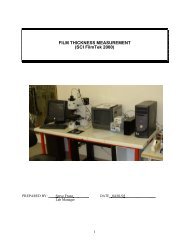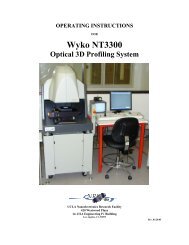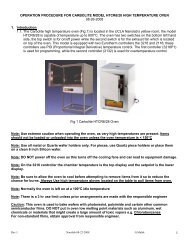Tystar Oxidation & Anneal Furnace Operation - Login | Nanolab, UCLA
Tystar Oxidation & Anneal Furnace Operation - Login | Nanolab, UCLA
Tystar Oxidation & Anneal Furnace Operation - Login | Nanolab, UCLA
Create successful ePaper yourself
Turn your PDF publications into a flip-book with our unique Google optimized e-Paper software.
oxidations. Offsets may change slightly from time to time or when the furnace tube is changed.<br />
Consult the log book recipe sheet for latest offsets. Use the preview mode to verify offsets are<br />
correct in the desired recipe. Change them to the log book value if necessary.<br />
When the furnace is opened it is normal for the front zone and center zone to cool off while<br />
the rear zone overheats. Temperature recovery may take up to an hour and these times are<br />
already built into the recipes. Keep in mind that the furnace can be ramped at ~10°C/min while<br />
cooling will be less than 5 °C/min. It is not desirable then to overheat the furnaces.<br />
These furnaces are meant to control between 450-1100°C. Do NOT process outside of<br />
these limits. Additionally, all wet oxide runs must be 800°C - 1100°C.<br />
The center zone should be stabilized (0 on the deviation meter) BEFORE attempting to adjust<br />
the end zones (via TempL or TempS) since the end zones are "slaved" to the center zone.<br />
FURNACE LOADING & UNLOADING:<br />
Although it is possible to incorporate load and unload steps into a recipe, the <strong>Nanolab</strong> prefers<br />
to Load and Unload from Recipe 0 to avoid any possibility of the furnace being open for<br />
prolonged times. There are 2 quartz boats kept in the tube at all times. For 25 wafers or less,<br />
always use the front boat for best uniformity. (Wafers near the rear will see a higher<br />
temperature during wet oxidations due to the torch temperature.) Dummy wafers are not<br />
required, but a clean bare silicon monitor should be run with your wafers to obtain oxide<br />
thickness. Position of these boats on the cantilever is critical; by using the front boat only and<br />
making sure it just touches the rear boat when you load it, you will guarantee proper boat<br />
placement. Face wafers forward with flats facing up. (Although the process does not require<br />
this, it will help us to troubleshoot problems in the future.) To Load your wafers (after fulfilling<br />
all of the aforementioned requirements):<br />
LOADING:<br />
1 Push PROGRAM button (light comes on), 0, ENTER<br />
2 Verify N2 flow is 3500 cc (3.5L/min); change it if necessary<br />
3 Verify Temperature is 800°C with AUTO TEMP on. Change it if necessary.<br />
4 Verify H2H/O2, H2L/N2, O2 Hi and O2 Lo are off.<br />
5 Verify LOAD light is OFF; push button if it is on.<br />
6 Turn on UNLOAD light by pushing UNLOAD button.<br />
7 Cantilever should slowly come out. The speed is determined by lab management<br />
and should be less than 9 inches/minute. Too fast a speed can result in wafer<br />
warpage or slip.<br />
8 When the cantilever is fully extended, use the steel fork to unload the front quartz<br />
boat onto the quartz sled (the steel bench may be used if the sled is not available).<br />
Do NOT set the hot boat on a wipe or anything else which may melt.<br />
9 Load your cleaned substrates (3 or 4 inch) so that each wafer sits in its own slot and<br />
is perpendicular to the boat. Up to 25 wafers may be loaded in this way. Keep all of<br />
the wafer facing forwards with flats all aligned upwards.<br />
10 Using the steel fork, carefully place the boat back onto the cantilever rods so that it<br />
is in front of and just touches the rear boat. Make sure the boat is centered on the<br />
rods.<br />
11 Turn off UNLOAD by pushing button (you must still be in PROGRAM mode.)<br />
12 Turn on LOAD by pressing LOAD button. Light comes on and cantilever slowly<br />
goes into the furnace tube.<br />
10


